
The World of Eshú and Pomba Gira

Biography
María Isabel Pedrera Pérez, better known as MAGA BETH, was born in Barcelona on February 9, 1970.
With an inherited profession, her grandmother and great grandmother introduced her in the world of High Magic; she showed, at an early age, a preference towards esotericism.
María Isabel attended basic and high school education and completed higher education with a diploma in Infant Education and Childcare, specialising her studies with the following courses:
–Educator for people with learning difficulties – Autism.
–Special needs – Dyslexia.
–Stimulation and development in education with disabilities.
–Psychopathic disorders in childhood.
–Speech Therapy.
–The teacher in school failure.
–Music therapy.
–Movement and play in the teaching practice.
She combined both studies and also specialised in parapsychology, hypnosis, occultism and astrology; and completed a Master in Quality Control and Environment.
As a good Aquarius, her restless soul led her to continue gaining experience but this time in the natural world, and earned a diploma in Naturopathy, Bach Flowers Remedies, Schüssler Salts, Dietetics and Nutrition, Lymphatic Drainage, Reflexology and Chiromassage.
María Isabel is the author of several books:
–El mágico mundo de las pirámides- Piramidología práctica y esotérica.
–Runas, símbolos mágicos.
–Diccionario de santería.
–Eshú y Pomba Gira, más allá del bien y del mal.
–The Great Secret of Holy Death
Throughout these years, María Isabel has collaborated in several radio programmes and esoteric fairs, has given lectures and conferences, and many Tarot, Runes and High Magic courses; and also participated in the First Congress of Mediums held in Spain.
Currently, she continues working in different fields spreading her knowledge.
Contact:
Web
Chapter 1 – what is eshu? Where does eshu come from?

There are so many definitions of Eshu that it is difficult to say which one is the most accurate. I personally believe they all are since every definition gives us a different point of view, but the information remains the same.
For some people Eshu is a naughty mischief-maker who creates confusion, has fun making people get stuck in nonsense, and enjoys scattering ideas and things. Eshu can really make you lose your nerve in a short period of time. For others, Eshu is a Machiavellian entity whose actions are only used for evil. Years and years of lack of information and a narrow-minded religious point of view, together with an absurd syncretism have disfigured the figure of Eshu.
Eshu is part of the tradition of the Afro-Brazilian cults, an ancient religion transmitted by mouth of word. These cults finally divided into:
– Umbanda
– Quimbanda
Eshu is in both.
I will explain the differences between Quimbanda and Umbanda in another chapter.
The origin of Quimbanda dates back to the19th century with ancient Macumba, a mixture of cults from Angola, Congo and Candomblé-de-caboclo. Years later, Macumba included Kardecist Spiritism and Occultism and became sorcery: this was then called Umbanda, while ancient Macumba was called Quimbanda.
These African cults underwent many changes and to make a review of all of them would be too long. Therefore, I will only explain the most relevant and strongest cults.
I will summarise these in 7 periods:
1- There were two main cults: the indigenous cults before the discovery of Brazil (indigenous religions and those of the Amazonian tribes) and the Portuguese European cults that arrived to Brazil, i.e., popular Catholicism and Kardecism. The mixture of both lead to Pajelanza.
2- The Afro-Brazilian cults from the North were called Candomblé and those from the South Batuques.
The Portuguese used these words to describe black people’s reunions. The government allowed these meetings to keep them busy and so that they would cause no problems. During the 19th century they divided into Sudanese and Bantu. The Sudanese integrated by the Angolan gave origin to the Menina.
3- Nagôs prevailed over the others: their Orishas, language and rituals reached very far. Together with Pajelanza they originated Candomblé-de-Caboclo in Bahia.
The combination of Angola Congo and Pajelanza gave rise to the Catimbó in the Northwest and in the North.
4- Nagôs are Muzurumlin, the Angola Congo and the Candomblé-de-Caboclo gave rise to the ancient Macumba, which later became sorcery.
5- Ancient Macumba together with Catholicism, Occultism and the Kardecist Spirit gave rise to a new religion: Umbanda.
Ancient Macumba transformed into a cult to Eshu and Quimbanda arose in Rio de Janeiro.
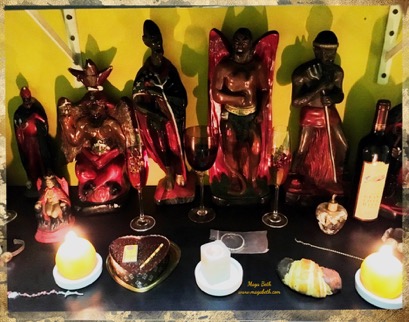
6- The cult to Eshu evolved and adapted different ceremonies and rituals from Candomblé, Batuque and Quimbanda.
7- In Brazil there are currently two types of Umbanda, the one from Angola combined with Candomblé: Omolocô, and the one from the South that approaches Batuque and is the crossed Umbanda.
On 16th November 1908 a new religion was born which was adopted by nearly everybody: Umbanda.
Quimbanda welcomed the influence that the Batu from Angola, Congo and Mozambique left in America. Quimbanda was based on Eshu, the element of nature that is part of a whole.
For them, Eshus are emaciated spirits: some are evolving spirits and others are quiumbas.
The temples of religion follow more or less the same guidelines as those of Umbanda.
There is an altar dedicated to one or several Eshus, depending on the owners of the place.
In Umbanda, Eshu is the communicator of the Orishas whereas in Quimbanda Eshu is a doctor, a fortune-teller, a healer, a shaman, an exorcists and a sorcerer, he has the power over all things.
Eshu’s powers may fix matrimonial disagreements, heal illnesses, provide success in love, reverse any request, or even cause death.
Eshu is the owner of the Earth, he has several names depending on the place where he manifests and the type of work, but there is always a head Eshu.
I have made a chart with the kingdoms of Eshu and Pomba Gira so as to classify them and know how to use them, also describing their tasks and their power level.
In Quimbanda, both Eshus and Pomba Giras are spirits of light. They are severe, authoritarian, fair, cheerful and responsible. They will never judge your actions, they will never decide if what you are doing is right or wrong, you ask them for help and in return you must thank them. If not, they will turn against you.
There are two types of Eshus in Quimbanda: eguns and those from the astral.

Eguns are the spirits of the followers of this religion, people who have evolved and after death continue to be with us working in this field, while those of the astral are the Quimbanderos. Quimbanderos rule, direct and administer the kingdom. Each Quimbandero has its own position and specific tasks.
Eguns are led by Eshus.
Eshu is on earth, on fire, in air, in water, and in cemeteries.
Eshu uses black because black is the hidden power and red energises the hidden.
Eshus are painted in red because red is the colour of strength, vitality and life.
Eshu is the lord of limit.
Always bear in mind that good and evil are not in Eshu but in the human being.
Reino Das Encruzilhadas (Kingdom of the Crossroads)
They dwell in the corners of crossroads. They are used when someone must choose a path in their life, to beat the enemies, and to put peace and justice in paper work issues. They break chains. They usually help the poor.
Reino Dos Cruzeiros (Kingdom of the Crossings)
They dwell in crossings and behind doors. They are called to do evil actions, they incite disturbance and hate. They make accidents happen.
Reino Das Matas (Kingdom of the Forests)
They dwell in mountains, fields, and in anything that is green. They carry a torch that protects against evil spirits. They know every herb and their use in rituals or works. They provide wisdom, peace and protection, and they cure diseases.
Reino Da Kalunga (Kingdom of the Cemetery)
They are emaciated spirits in a state on evolution. They take care of the other souls and they overcome the enemies. They dwell in cemeteries. They bring all types of death, prevent diseases, heal illnesses and undo works done in the cemetery.
Reino Das Almas (Kingdom of the Souls)
They dwell in all the high places such as hospitals, morgues, wakes and church doors. They guide the souls of the cemeteries to their final location so that they do not get lost, especially those recently deceased. They work with the souls of mediums. They cleanse chakras. They defend people that are attacked by spirits without light.
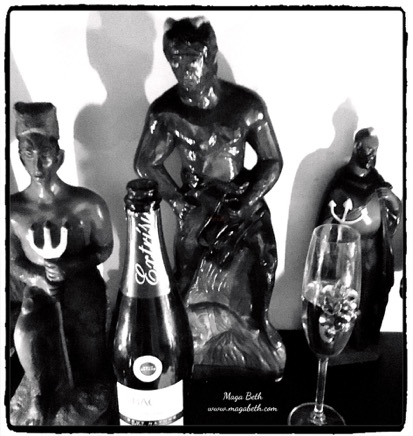
Reino Da Lira (Kingdom of the Lyre)
They dwell in places of vice, fun and sex, such as nightclubs, casinos, brothels, etc. They are good for business and for strokes of luck. They also help people to get job opportunities. They join couples and strengthen friendships.
Reino Da Praia (Kingdom of the Beaches)
They dwell in the sand of beaches and in the sea, where the Mass for the Dead takes place or where we give our last goodbye to the religious belongings of those who were in life a son or daughter of religion. They send works back and regenerate and calm the place.
Organisational chart
The organisation chart of the Eshu law consists of a main Eshu, or supreme commander, that is composed of three entities. These three entities have the same power and are the following:

– Eshu Maioral
– Eshu Rei
– His Royal Highness Eshu Rei Das 7 Encruzilhadas
Three Princes and two Kingdoms depend on them.
The Princes are:
–Eshu 7 Encruzilhadas
–Eshu 7 Cruzeiros
–Eshu Rei Das 7 Encruzilhadas
The Kingdoms are:
– Kingdom of Eshu Kalunga
– Kingdom of Omulú
Each Prince has two Dukes:
– Eshu 7 Encruzilhadas: Eshu Marabo and Eshu Mangueira.
– Eshu 7 Cruzeiros: Eshu Tranca Ruas and Eshu Tiriri.
– Eshu Rei Das 7 Encruzilhadas: Eshu Veludo and Eshu Dos Rios.
The Kingdoms are divided into the following subdivisions:
The Kingdom of Eshu Kalunga includes:
–Eshu Dos Ventos
–Eshu Quebra Galho
–Pomba Gira
–Eshu 7 Cachoeiras
–Eshu 7 Poeiras
–Eshu Gira Mundo
–Eshu Das Matas
–Eshu 7 Pedras

-Eshu Morcego
–Eshu Dos Cemitérios
–Eshu 7 Portas
–Eshu 7 Sombras
–Eshu Tranca Todo
–Eshu Pedra Preta
–Eshu Capa Preta
–Eshu Maraba
The Kingdom of Eshu Omulú has two Secretaries:
–Eshu Caveira
–Eshu Meia Note
The following Eshus command a smaller group.
Eshu Caveira commands:
–Eshu Tata Caveira
–Eshu Brasa
–Eshu Bemba
–Eshu Mare o Lodo
–Eshu Carangola
–Eshu Arranca Toco
–Eshu Pagao
Eshu Meia Note commands:
–Eshu Mirim
–Eshu Pimenta
–Eshu Male
–Eshu 7 Montanhas
–Eshu Ganga
–Eshu Kaminaloa
–Eshu Quirombó
and an independent Eshu, Eshu Curado.

Pomba Gira is a feminine Eshu that belongs to the Kingdom of Eshu Kalunga. It has its own organisation chart that I will describe in detail in another chapter dedicated to Pomba Gira.
Next you will find an organisation chart to locate the different Eshus.
Each Eshu has a different name and therefore a different task or work. Each Eshu serves for a specific task: they are independent but compatible.
The use of the elements of the organisation chart of the Eshu law is as follows:
–Eshu Maioral, Eshu Rei, and Royal Highness Rei Das 7 Encruzilhadas represent the energy, the balance of nature, the greatest, and the source of absolute power.

-Eshu 7 Encruzilhadas opens locks and breaks doors.
–Eshu 7 Cruzeiros prevents accidents and monitors everything.
–Eshu King 7 Encruzilhadas represents the victory over our enemies.
–Eshu Marabo monitors the physical plane.
–Eshu Mangueira recharges energies.
–Eshu Tranca Rua is the shock guard.
–Eshu Tiriri keeps your health and facilitates the path for attraction.
–Eshu Veludo is the guardian for the correct functioning of spiritual works.
–Eshu Dos Rios receives the offerings in rivers.

-Eshu Kalunga breaks the works done in cemeteries.
–Eshu Dos Ventos makes everything disappear quickly.
–Eshu Quebra Galho makes you move forward without fearing the obstacles.
–Pomba Gira makes you achieve your happiness in love and a strong attraction of the opposite sex.
–Eshu 7 Cachoeiras attains firmness on Earth.
–Eshu 7 Cruzes watches over the spirits of murderers and suicidal persons.
–Eshu Tronqueiras protects the corners of a Quimbanda temple.
–Eshu 7 Poeiras is the guardian of the mountain paths.
–Eshu Gira Mundo changes your luck.
–Eshu Das Matas is invoked for works, rituals and ceremonies.
–Eshu 7 Pedras helps you in everything related to high magic.
–Eshu Morcego cures illnesses.
–Eshu Dos Cemitérios can achieve almost everything.
–Eshu 7 Portas opens all doors.
–Eshu 7 Sombras for any spiritual work in any place.
–Eshu Tranca Todo is the Eshu you invite to feasts and banquets so that everything goes alright.
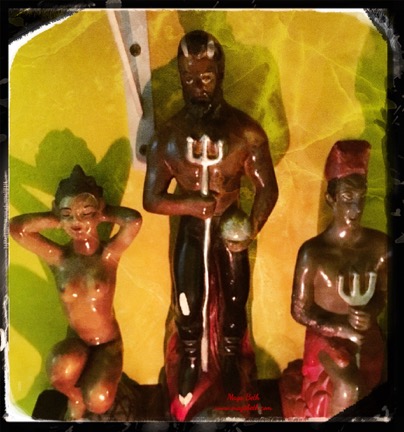
-Eshu Pedra Preta is the owner of finances and economic success.
–Eshu Capa Preta coordinates the spiritual works of any temple.
–Eshu Maraba has the power over all nature phenomena.
–Eshu Tata Caveira gets the vices out of people.
–Eshu Brasa dominates fires.
–Eshu Bemba gives lovers.
–Eshu Mare o Lodo cleans the place of disturbing spirits.
–Eshu Carangola for Cabalistic works.
–Eshu Arranca Toco makes wealth arrive to your hands soon.
–Eshu Pagao takes care of marriage separations and new couples.
–Eshu Mirim is whimsical and playful. You can ask for any nonsense to this Eshu.
–Eshu Pimenta is a magician who gives power.
–Eshu Male does witchcraft or evil spells.
–Eshu 7 Montanhas grants anything that is for the earth and the forests.
–Eshu Ganga guards and protects corpses and breaks hexes.
–Eshu Kaminaloa takes care of the bodies.
–Eshu Quirombo helps to achieve all your goals.
–Eshu Curado solves illnesses.
Chapter 2 – do we know eshu?

I have a great deal of respect when talking about Eshu and I sometimes think I need to know more every day. Therefore, I devour any information that comes to my hands in just a few seconds and then I compare everything I have read. I have learnt that everything related to Eshu is a mystery because it is the bearer of the force that surrounds our very existence.
Red and black are the colours that represent Eshu.
Red represents strength, vitality, energy, efficiency, impulse, courage, power, nerve, and impetus. Black represents what is hidden, the furtive, the veiled, the clandestine and the arcane.
All these characteristics depict Eshu perfectly, and red and black are the best colours to physically represent Eshu.
Actually, the word Eshu means messenger. Eshu is the astral messenger of the Orishas: only Eshu can cross dimensions and go to the other side, see the future and the past. Eshu’s power is uncontrollable and its strength infinite.
It is said that Eshu is a messenger, an astral police. To talk about Eshu also means to talk about Quimbanda, Umbanda, or Candomblé (the different Afro-Brazilian cultures in which Eshu is present).
Eshu is the balance of all these cultures, the link that makes them all work, although Eshu has specific characteristics in each culture.
Eshu protects and takes care of humans but does not assume their mistakes. Eshu gives women and men the possibility of doing good and evil. Eshu only asks for a reward for his work, which must be always given and never forgotten since his anger can be terrible.
Eshu is a very playful, boisterous, tireless, and naughty entity. Eshu likes to make jokes to people and loves to have fun. This entity knows everyone’s weak points and if someone offends him, he will use all the information so that her/his life is much more complicated, and he will not appear when his help is needed.
Eshu puts temptations in people’s way to allow them the freedom to choose the path they want to follow and assume their own responsibilities never held Eshu accountable.
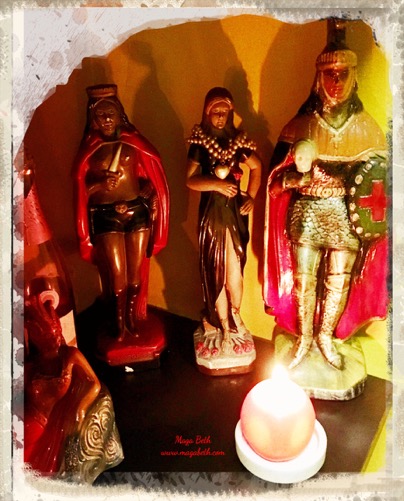
Eshu is an entity that regulates karma: he puts difficulties and temptations on the way, but also gives people the possibility of rejecting or accepting the spiritual path, the place of carnal, earthly and material temptations. People decide and Eshu acts.
Eshu carries out the work entrusted to the Orishas and the works that are entrusted to him.
Every Eshu works for a specific Orisha and every Eshu has its own assistants, thus forming a perfect hierarchical organisation.
Eshu is spiritual with an individual mission and with his own work (see Eshu law chart).
We all follow God's commands and we always try to do good. The bad guy is not Eshu, but each one of us with our attitudes and behaviour, grudges, hatreds and resentments gathered in our hearts that make us act in one way or another.
No Orisha will listen to you unless you have entrusted your request to an Eshu first.
Eshu does neither good nor evil: he fulfils the orders we give him. He is seen as a playful and irresponsible child who enjoys creating confusion between us and the Orishas. What he does is our own responsibility because he does not distinguish between good and evil.
There are no religions or negative entities, but people with bad intentions who will do evil and people with good intentions who try to solve evil. The existence of both is necessary to balance the functioning of the universe.
Eshu is the universal magical agent, the envoy, the Orishas’ messenger: hence, he is the first to receive all offerings.
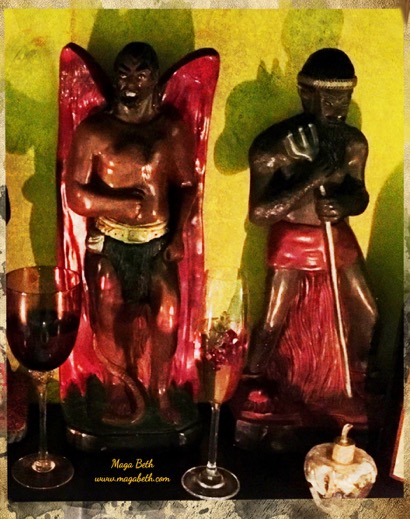
Before giving an offering to an Orisha you must first pay tribute and sacrifice to Eshu. If Eshu is relaxed and eating, he will be happy and then, he will allow you to perform the ceremony for the Orisha peacefully.
Eshu is the lord of the roads, the owner of the land production and everything related to fertilisation and productivity. Eshu spoke to the Orishas and told them that he would continue being their messenger but that he would treat humans differently: he would make them live with their fears and would scare them. He would become the devil for white people so that his own people would stop suffering slavery. He would strive with their emotions, suspicions, apprehensions, mistrust, turbulence and doubts so that his people could have a better existence. The Orishas reflected on those words and sent their Eshus to the Earth. According to the legend, Eshus became the devil for white people’s dark souls from then on.
Eshu is identified as the devil for Christians because the missionary priests found many difficulties, conflicts and problems when trying to impose their religion by force on slaves: too many gods and divinities for a people they were trying to subjugate.

Missionaries were forced to adapt to the whole Menina Pantheon. However, we must not forget that at the time Christians lacked a demon and thus, who better than Eshu to become their devil? Christians did not know Eshu and their own ignorance made them fear him; they did not even bother to find out that Eshu was the one who had more similarities with people and that all the requests made by slaves were related to their own life issues.
Humans fear what they do not know, and the dominant white feared the submissive black who worshiped the devil, since he protected them from injustice, infamy, and the absolutism of white people.
Fear along with ignorance works miracles: panic took over the whites at crossroads, near their houses, etc. Offerings made by ebos to Eshu for whatever request, where just seen as the demon thrown against them.
Another asset of identifying Eshu with a demon was his representation in red and black, the symbolism of masculinity that he represented and his physical appearance with a large phallus in his hand. Such image could only represent a demon.
Offerings must always be given to Eshu first: this is the basis that everybody knows, but what is the origin of this tradition?
There are several legends:
–Eshu was the owner of divination which was given to him by Orunmila. However, Eshu was tired because humans used to bother him day and night, so he made a pact with Ifá. Eshu wanted prominence and primacy in every ceremony and Ifá promised this to him if he gave him the gift of divination that he had. Eshu agreed and so he became the first to receive offerings.

-Eshu found out that Obbatalá was sick and that no one could solve his problem. He went to see him with some herbs and he cured him. As a reward for this, Obbatalá said that Eshu would have to be served first in every ceremony.
–The king of Congo had three children: Shango, Ogun and Eshu, who was a troubled and problem child. One day, the king died and thereafter every time they made a sacrifice to the spirits or made a religious party nothing went right, the prayers to the gods were not heard, flocks died of epidemics, crops were lost, men, women and children became ill. People then asked a babalawo who talked to the obis. The obis said that Eshu was jealous and wanted part of the sacrifices. No one remembered Eshu, the small black boy who was always annoying everyone. Therefore, from then on, nothing could be done without Eshu being served in the first place so as not to upset him.
Ifá is Eshu’s companion and messenger. Ifá carries the destiny of the universe dictated by the Orishas: he is their spokesman and messenger.
Eshu opens and closes the roads, he has the key to all the doors, he is the son of Oya, the messenger of Obbatalá, the brother of Ogun and the comrade of Shango.
He only pays homage to the greater Orisha. One of its symbols is a snake because he is always sleeping on the roads and Eshu is the owner of roads.
Eshu is a Menina word that means sphere, the cosmic energy in movement, the enterprising agent, the ferment and the manufacturer of reactions.
He likes doing good by healing, removing personal black magic works, undoing works or stopping spells. When a negative entity is removed from someone, quiumbas are in charge of taking it to the right place in the astral.
He is a vigilant light entity for all emaciated souls to evolve.
Everyone calls him the astral watchman, a policeman who controls every soul in its right location according to its purification or spiritual elevation.
He controls the Earth’s incarnations, he keeps the incarnations of the spirits of low evolution at bay so that they do not contact us.
As well as attending our calls and requests, he takes the souls of dead people to the place where they belong, he must maintain the order that God has created.

